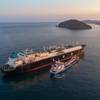There are two main ingredients to common rail fuel injection, one being the freedom to choose injection pressure and timing totally independently of the engine load. The other is computerized control, which makes it possible to consider several engine parameters and optimize the injection and combustion in each load situation.
The Wärtsilä Common Rail development was kicked off for both medium-speed engines and low-speed engines at a seminar in June 1997. This year both medium-speed engines and low-speed engines will enter commercial service.
The Wärtsilä Common Rail concept for four-stroke engines comprises: Camshaft driven high-pressure pumps; Accumulators for elimination of pressure waves; All in hot box for maximum safety; Engine driven control oil pump for easy black start; Suction control of fuel flow for highest efficiency; Low cam load for maximum reliability.
The Sulzer Common Rail concept, i.e. the RT-flex, for low-speed engines comprises: Engine driven pump unit for high pressure fuel and oil for exhaust valve actuation; One rail valve per injector for combustion optimization flexibility; Volumetric control of fuel amount; Modular build-up, including control system, for maximized redundancy.
At the moment the Wärtsilä 46 and Wärtsilä 32 are available for deliveries during this calendar year, and the Wärsilä 38 and Sulzer ZA40 are scheduled for pilot delivery later. On the RT-flex side the RTA58 size is already delivered and therefore available, and orders have also been received for the RTA60C.
Low NOx emission
"Low NOx Combustion" made it possible to drastically reduce NOx emissions and at the same time in all cases improve fuel consumption. Further small improvements in NOx emissions could be achieved by accepting a higher fuel consumption. However, CO2 emissions are considered to be even more important in the future than NOx emissions, and therefore Wärtsilä has chosen to go for methods that all the time keep fuel consumption low.
During the 1980s, Exhaust Gas Recirculation was much discussed as a method to reduce NOx and it certainly works. But even when the fuel has insignificant amounts of sulfur, the practical application of EGR causes unacceptable operational problems. The introduction of water in one form or another into the engine cylinder seems to be the feasible way forward. The methods chosen by Wärsilä are Direct Water Injection, Combustion Air Humidification and Steam Injection. Fuel-water emulsion certainly is an opportunity, but it has been postponed until common rail injection systems are introduced in all engines because fuel-water emulsion in a conventional injection system causes considerable problems.
An exciting new development at the moment is the Combustion Air Saturation System, where a special HI-FOG nozzle is used to introduce water after the turbocharger in the form of very small droplets. These droplets evaporate fast, and further heat is introduced in the air cooler, which now acts as an air heater, resulting in combustion air with about 60 g humidity per kg air. With this amount of water it is possible to arrive at NOx levels of 3 g/kWh. The HI-FOG nozzles and the water technology are provided by Marioff. For low-speed engines the Water Cooled Rest Gas (WaCoReG) is pursued. This system utilizes the same mechanism as an EGR system would, i.e. introducing some rest gas into the combustion space.
Fuel flexibility
Wärtsilä has given priority to the development of engines capable of operating on Orimulsion and even bottom oils. One logic is that these fuels are so cheap that it is possible to apply a considerable amount of exhaust gas cleaning technologies and still deliver energy at a cost-effective price. Geologists and chemists seem to agree that the large salt water seas have unlimited capacity to take sulfur emissions. The trick seems to be to get the emissions to touch the salt water before they touch sensitive vegetation on land. Sea water scrubbing sounds like an interesting opportunity if such a device could be made to work. For this reason Wärtsilä has taken up the development of a scrubber system together with Marioff.
Minimized waste
Increased efforts on numerous fronts have been designed to minimize diesel engine wastes, including used lubricating oil, used oil filter cartridges, and spare parts scrap. The way to avoid used lubricating oil is never to have to change the oil. That was quite easy in the past when oil consumption was high. With the introduction of the antipolishing ring the threshold became higher. However, the oil companies have responded well to the challenge, and at the moment an oil consumption of 0.4 g/kWh is enough for the best lubricating oils to keep them stable without oil changes. Development is going on all the time.
Wärtsilä, Marioff To Cooperate On Emission Control Technolgy
Wärtsilä and Marioff, agreed earlier this year to cooperate within the area of emission control technologies for reciprocating engines. Marioff is a specialist in creating humidity, while Wärtsilä needs humidity for reduction of NOx in diesel, and perhaps gas engines.
The introduction of water into the combustion space of a diesel engine in one way or another reduces NOx formation. There are two main mechanisms for this phenomenon, one being the addition of mass in the combustion space. The other effect may be evaporation of the water in the combustion space during combustion. Both mechanisms are utilized in the Direct Water Injection system, which is one of the technologies promoted by Wärtsilä. However, these technologies cannot be used for very low NOx, because the evaporation of the water in the combustion space will steal some of the combustion energy. For the lowest NOx values it is therefore desirable to go another way, and that is to evaporate the water before it enters the combustion space. Wärtsilä created such a system in the 1980s called Combustion Air Humidification. At that time it was not possible to add very much water into the combustion air due to sensitive cylinder liner piston ring technology. Since the introduction of the antipolishing ring diesel engines have been virtually insensitive to humidity in the combustion air, Wärtsilä decided to take up the development of this system again. Here the Marioff technology to create very small water droplets, HI-FOG, comes in handy because when water is introduced directly after the turbocharger in an environment of more than 200 degrees C and more than 75 m/s air velocity, the small water droplets will evaporate fast.
Sponsored Content
Innovative Hull Maintenance: Profitable & Green

December 2024
 Read the Magazine
Read the Magazine

 Read the Magazine
Read the Magazine
This issue sponsored by:

Propulsion Choices begin with Fuel and End with Politics
Subscribe for
Maritime Reporter E-News
Maritime Reporter E-News is the maritime industry's largest circulation and most authoritative ENews Service, delivered to your Email five times per week











